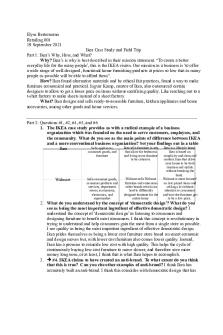IKEA Case Study PDF

| Title | IKEA Case Study |
|---|---|
| Course | Principles of Strategy |
| Institution | Yeshiva University |
| Pages | 1 |
| File Size | 64.5 KB |
| File Type | |
| Total Downloads | 78 |
| Total Views | 168 |
Summary
Case Study Assignment...
Description
David Rivkin Professor Finkel
Principles Of Strategy IKEA Case Study
BRIEF SUMMARY: Started by a small boy on a farm- Ingvar Kamprad- started by selling matches and Christmas cards. IKEA’s first step into internationalization was opening stores in other Scandanavian countries. IKEA continued to identify big countries with high sales volume potential. PORTER’S NATIONAL DIAMOND FRAMEWORK: 2 EXAMPLES FACTOR CONDITIONS: S weded is Europe’s second biggest afforested area. Sweden faced harsh winters and during the winter they crafted furniture and other goods using the excess timber available. Supplying nearby areas with furniture became their source of income during harsh winters when they couldn’t farm. Sweden is also known for their numerous design schools and universities. PERFECT LOCATION FOR IKEA DEMAND CONDITIONS: IKEA is sensitive to its closest customers- SWEDISH design has shaped IKEA’s furniture products- Swedish are environmentally sensitive and IKEA prides themself on “Low cost but not at a cost to the environment” The IKEA way- making the best possible with the resources at hand- value for moneyGLOBALIZATION OF IKEA’s SUPPLY CHAIN- IKEA recognized benefits of int’l distrubed supply chain chain very early on changing from Swedish to Polish supply sources to cut costs- As the company grew its VALUE CHAIN became more distributed. Product design remained in Sweden, Headquarters moved to The Netherlands- logistics center in Germany- 2000 supplier network-low cost ● IKEA manufacture subsidiary - controls entire value chain - manages long term forest contracts, sawmills, producing and distributing self assemble furniture ○ Owns facilities in US and Russia FOREIGN ENTRY STRATEGY- All IKEA retailers are “franchisees” with some formal agreement with IKEA Systems BV- the IKEA subsidiary that owns and operates the IKEA- IKEA stores for all intensive purposes are subsidiaries of INGKA the parent company of IKEA. ● Conventional Franchise- raising capital, royalty income, gaining local knowledge from that country ○ IKEA only does this process when required to by government/where local knowledge is key to its success ● Potential franchisees have to show that they have a presence in the local market, possess knowledge and experience to be successful in that location, and subscribe to IKEA’s values ● IKEA monitors stores through regular audits IKEA GOES GLOBAL- IKEA has sought to introduce its Swedish furniture to the world through its stores, product range, and management practices in all the countries it operates in. ● All stores look the same- yellow/blue Swedish flag colors- offer same retail experience ● Some countries have different specifications- Japan furniture is smaller so IKEA has to adapt by producing smaller furniture ○ Japan kitchens require automatic locks on cabinets for earthquake protection ● In US- IKEA furniture bigger than Europe because US rooms are bigger and fit bigger items ● Management practices have faced pressure in different countries as different cultures require different management methods ○ Example- some countries like flat top furniture and other countries see it as a negative aspect
POV: IKEA’s keys to success are its abilities to adapt to different cultures around the world while still having a basic management formula and company vision. Through its international supply and competitive advantage and its 2000 suppliers who meet the specifications of IKEA, IKEA stays ahead of the competitors and can see endless success...
Similar Free PDFs

Ikea - Ikea Case Study
- 5 Pages

IKEA CASE Study
- 4 Pages

Case study IKEA Questions
- 5 Pages

IKEA Case Study - Management
- 2 Pages

IKEA Case Study
- 1 Pages

IKEA - Case Study
- 21 Pages

Case Study - IKEA
- 4 Pages

IKEA - Case study
- 8 Pages

IKEA Case Study Analysis
- 7 Pages

Ikea Case - Ikea case summary
- 1 Pages

Ass1 Case Study IKEA 3
- 3 Pages

IKEA Case Study used in class
- 15 Pages
Popular Institutions
- Tinajero National High School - Annex
- Politeknik Caltex Riau
- Yokohama City University
- SGT University
- University of Al-Qadisiyah
- Divine Word College of Vigan
- Techniek College Rotterdam
- Universidade de Santiago
- Universiti Teknologi MARA Cawangan Johor Kampus Pasir Gudang
- Poltekkes Kemenkes Yogyakarta
- Baguio City National High School
- Colegio san marcos
- preparatoria uno
- Centro de Bachillerato Tecnológico Industrial y de Servicios No. 107
- Dalian Maritime University
- Quang Trung Secondary School
- Colegio Tecnológico en Informática
- Corporación Regional de Educación Superior
- Grupo CEDVA
- Dar Al Uloom University
- Centro de Estudios Preuniversitarios de la Universidad Nacional de Ingeniería
- 上智大学
- Aakash International School, Nuna Majara
- San Felipe Neri Catholic School
- Kang Chiao International School - New Taipei City
- Misamis Occidental National High School
- Institución Educativa Escuela Normal Juan Ladrilleros
- Kolehiyo ng Pantukan
- Batanes State College
- Instituto Continental
- Sekolah Menengah Kejuruan Kesehatan Kaltara (Tarakan)
- Colegio de La Inmaculada Concepcion - Cebu



